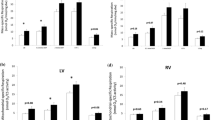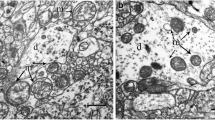Abstract
Chronic exposure of mammals to hypoxia induces a state of anorexia. We aimed to determine the role played by diet restriction in the alterations of myocardial energy metabolism occurring under chronic hypoxia in order to detect the specific effects of hypoxia per se.
Adult female rats were exposed to normobaric hypoxia (Fi O2 = 0.10) for three weeks; pair-fed rats, kept under normoxic conditions, received the same amount of food as hypoxic rats. The oxidative capacity of myocardial ventricles and some skeletal muscles was evaluated using permeabilized fibers. Several metabolic enzyme activities were measured on extracts from myocardium and soleus.
Diet restriction increased the activity of lactate dehydrogenase in both ventricles while it augmented phosphofructokinase and pyruvate kinase activities only in the left ventricle and depressed the respiratory rate in the right ventricle only.
Hypoxia per se induced a rise in hexokinase activity in all studied oxidative muscles and a fall of hydroxy-acyl CoA-dehydrogenase activity in both myocardial ventricles. The respiratory rate and the citrate synthase activities were unaffected by hypoxia.
We conclude that chronic hypoxia per se leads to specific alterations in myocardial metabolism that could favor the use of exogenous glucose at the expense of free fatty acids without any change in the oxidative capacity.
Similar content being viewed by others
References
Leverve X: Metabolic and nutritional consequences of chronic hypoxia. Clinical Nutrition 17: 241–251, 1998
Henriksson J: Energy metabolism in muscle: its possible role in the adaptation to energy deficiency. In: J.M. Kinney, H.N. Tucker (eds). Energy Metabolism: Tissue Determinants and Cellular Corollaries. Raven Press, New York, 1992, pp 345–366
Roderman NB, Goodman MN, Berger M, Hagg S: Effect of starvation on muscle glucose metabolism: Studies with the isolated perfused rat handquarter. Fed Proc 36: 171–176, 1977
Russel DMcR, Atwood HL, Whittaker JS: The effect of fasting and hypocaloric diets on the functional and metabolic characteristics of rat gastrocnemius muscle. Clin Sci 67: 185–194, 1984
Moret P: Myocardial metabolism: acute and chronic adaptation to hypoxia. Med Sport Sci 19: 48–63, 1985
Sivitz WI, Lund DD, Yorek B, Grover-Mckay M, Schmid PG: Pretranslational regulation of two cardiac glucose transporters in rats exposed to hypobaric hypoxia. Am J Physiol 263: E562–E569, 1992
Holden JE, Stone CK, Clark CM, Brown WD, Nicles RJ, Stanley C, Hochachka PW: Enhanced cardiac metabolism of plasma glucose in high-altitude natives: Adaptation against hypoxia. J Appl Physiol 79: 222–228, 1995
Barrie E, Heath D, Arias S, Harris P: Enzymes activities in red and white muscles of guinea-pigs and rabbits indogenous to high altitude. Environ Physiol Biochem 5: 18–26, 1975
Harris P, Castillo Y, Gibson K, Heath D, Arias-Stella J: Succinic and lactic deshydrogenase in myocardial homogenates from animals at high and low altitude. J Mol Cell Cardiol 1: 189–193, 1970
Hochachka PW, Stanley C, Merkt J, Sumar-Kalnuwski J: Metabolic meaning of elevated levels of oxidative enzymes in high altitude adaptative animals: an interpretative hypothesis. Respir Physiol 52: 303–313, 1982
Koob GF, Annau Z, Rubin RJ, Montgomery MR: Effect of hypoxic hypoxia and carbon monoxide on food intake, water intake, and body weigh in two strains of rats. Life science 14: 1511–1520, 1974
Barrie SE, Harris P: Effects of chronic hypoxia and dietary restriction on myocardial enzyme activities. Am J Physiol 231: 1308–1313, 1976
Hochachka PW: Adaptability of metabolic efficiencies under chronic hypoxia in man. In: Surviving Hypoxia: Mechanisms of Control and Adaptation. CRC Press, 1993, pp 128–135
Gold AJ, Costello LC: Effects of altitude and semi-starvation on heart mitochondrial function. Am J Physiol 227: 1336–1339, 1974
Ou LC, Tenney SM: properties of mitochondria from hearts of cattle acclimatized to high altitude. Res Physiol 8: 151–159, 1970
Vergnes H: Modifications in activities of enzymes in extracts from myocardia of rats living at high altitude. Cardiology 56: 222–223, 1971
Reynafarje B: Effect of chronic hypoxia on the kinetics of energy transformation in heart mitochondria. Cardiology 56: 206–208, 1971/72
Veksler VI, Kuznetsov AV, Sharov VG, Kapelko VI, Saks VA: Mitochondrial respiratory parameters in cardiac tissue: A novel method of assessment by using saponin-skinned fibers. Biochem Biophys Acta 892: 191–196, 1987
Novel-Chaté V, Mateo P, Saks VA, Hoerter JA, Rossi A: Chronic exposure of rats to hypoxic environment alters the mechanism of energy transfer in myocardium. J Mol Cell Cardiol 30: 1295–1303, 1998
Srere PA, Brazil H, Gonen L: The citrate condensing enzyme of pigeon breast muscle and moth light muscle. Acta Chem Scand 17: S129–S134, 1963
Llorente P, Macro R, Sols A: Regulation of liver pyruvate kinase and the phosphoenolpyruvate crossloads. Eur J Biochem 13: 45–54, 1970
Opie LH, Newsholme EA: The activities of fructose 1,6-diphosphatase, phosphofructokinase and phosphoenolpyruvate carboxylase in white muscle and red muscle. Biochem J 103: 391–399, 1967
Lowry OH, Passonneau J: A flexible system of enzymatic analysis. Academic Press, New York, 1972, pp 146–218
Bigard AX, Sanchez H, Birot O, Serrurier B: Myosin heavy chain composition of skeletal muscle in young rats growing under hypobaric hypoxia conditions. J Appl Physiol, 2000 (in press)
Genovese A, Chiariello M, Latte S, DeAlfieri W, Condorelli M: Bilateral ventricular hypertrophy in rats exposed to acute or chronic hypobaric hypoxia. Respiration 44: 289–293, 1983
Schneider M, Wiese S, Kunkel B, Hauk H, Pfeiffer B: Development and regression of right heart ventricular hypertrophy: Biochemical and morphological aspects. Z Kardiol 76: Suppl. 3. 1–8, 1987
Abdelmalki A, Fimbel S, Mayet-Sornay MH, Sempore B, Favier R: Aerobic capacity and skeletal muscle properties of normoxic and hypoxic rats in response to training. Eur J Physiol 431: 671–679, 1996
Author information
Authors and Affiliations
Rights and permissions
About this article
Cite this article
Daneshrad, Z., Garcia-Riera, M., Verdys, M. et al. Differential responses to chronic hypoxia and dietary restriction of aerobic capacity and enzyme levels in the rat myocardium. Mol Cell Biochem 210, 159–166 (2000). https://doi.org/10.1023/A:1007137909171
Issue Date:
DOI: https://doi.org/10.1023/A:1007137909171




